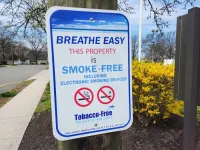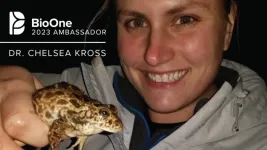(Press-News.org) Genome editing is used to modify the genes of living organisms to elicit certain traits, such as climate-resilient crops or treating human disease at the genetic level. It has become increasingly popular in agriculture, medicine and basic science research over the past decade, and will continue to be relevant and utilized well into the future. Given this prevalence, researchers at the University of California San Diego have started an outreach program that introduces genome-editing technologies to high school students.
Assistant Professor of Chemistry and Biochemistry Alexis Komor, and Ph.D. candidates Mallory Evanoff and Carlos Vasquez, designed the Genome Editing Technologies Program as a way to educate students on base-editing technologies, expose them to scientists from diverse backgrounds and invite questions about college, professional development, and the everyday life of a graduate student or faculty member within academia. The program is detailed in April 20 issue of The CRISPR Journal.
Base editors enable scientists to introduce point mutations at targeted sites in the genome of living cells with high efficiency and precision and, thus, have the therapeutic potential to treat thousands of human genetic disorders. Proof-of-concept studies have already demonstrated this technology’s potential in cell therapies and in treating progeria, sickle cell disease and liver diseases.
“As we were testing out some of these tools, we asked ourselves, how do we make base editors accessible to high schoolers? How do we make this process really visible?” said Evanoff.
Komor’s team generated a base-editing reporter system using E. coli bacteria. In this system, base-editing activity results in the expression of green fluorescent protein (GFP). The team installed a mutation in the bacterium’s GFP gene to remove its fluorescence. To emphasize the connection to genetic diseases, this phenotype is called “GFP-itis,” and students are tasked with “curing” the bacteria. Using base-editing technology, students correct the mutation back to wild-type, resulting in bacterial cells that fluoresce green.
The program happens over three days, creating a more meaningful partnership with the school and building a better foundation of trust with the students. “We wanted the students to get to know us better and feel comfortable asking questions about a career in STEM,” said Komor. “A popular question is simply, ‘How do I get into undergraduate research?’ One of the students in the first school we visited, Sage Creek High School, is actually an undergraduate researcher in our lab now.”
That student is Preety Iyer, a first-year human biology major, who recalled Komor’s visit to her high school as “an amazing opportunity to get hands-on experience with gene-editing technology. It seemed like an intangible concept to me when I was learning about it in my biology classes. Being walked through the entire process and being able to do it myself strengthened my understanding of DNA and gene editing.”
Iyer plans to become a doctor working with patients who have rare genetic disorders, and she’s excited to gain more valuable hands-on experience in Komor’s lab: “I’ve been able to use equipment and practice techniques, like flow cytometry and plasmid preparation, that other students don’t get to use until later in their academic careers.”
So far, the Genome Editing Technologies Program has visited three local high schools. The schools have had well-developed science classes and much of the equipment needed to run the experiment. The majority of students had also heard of or learned about genome engineering before. Now that Komor’s team has run the program a few times and solicited feedback from students, they hope to expand to schools without such robust science programming.
“My high school background in science wasn’t strong in large part because of the lack of mentorship,” said Vasquez. “It’s important to us to reach students who may not have even considered a career in STEM or medicine. To look in their eyes and instill confidence, to show we believe in them — having someone like that when I was in high school would have made a world of difference.”
The make the experiment as accessible as possible, the team has simplified the base-editing experiment and provides all the necessary equipment. Accessibility also means making the program available to other institutions that may want to implement something similar. Interested scientists or instructors can order plasmid materials from AddGene, a worldwide nonprofit plasmid repository. These plasmids are the DNA needed to make the GFP-itis cells, as well the plasmids needed to as "cure" GFP-itis.
The goal of the program is not only to make base editing accessible to high school students, but also to encourage critical thinking and reflect on base editing in social and cultural contexts. Komor’s team asked students to think about the difference between a disease and a trait and to consider the implications of germline genome editing, in which edits are inherited by all future descendants of the edited individual, regardless of whether those descendants consent to the procedure.
“The ethical discussion is what hits a home run with the students,” said Vasquez. “They’ll be responsible for future gene-editing policies. It’s interesting to see them thinking about the ethical side of science.”
“We’ve had some really good discussions about what is a disease and what is a trait,” stated Evanoff. “If we have the ability to make genetic-disease corrections, who will be able to afford those treatments? Where does the equitability lie in this technology? We don't have the answers to that. I say to students, ‘That's going to be your job to figure out!’”
This research was supported by the National Science Foundation (MCB-2048207), the National Institute of General Medical Sciences (T32 GM007240-41), the National Institute of Health (T32 GM112584), the Howard Hughes Medical Institute (GT13672 and the Gilliam Fellowship Program) and the National Academies of Sciences, Engineering, and Medicine Ford Foundation Predoctoral Fellowship Program.
END
High school students learn the basics of base editing to cure “GFP-itis”
Outreach program introduces local students to genome engineering and a career in science
2023-05-04
ELSE PRESS RELEASES FROM THIS DATE:
Awardees named for $15 million research project on CVD health impacts of chronic stress
2023-05-04
DALLAS, May 4, 2023 — Teams of research scientists from three universities will lead an innovative $15 million project to study the biological mechanisms of chronic stress that can increase cardiovascular disease risk. The Strategically Focused Research Network (SFRN) on Biologic Pathways of Chronic Psychosocial Stressors on Cardiovascular Health of the American Heart Association, the world’s leading voluntary organization dedicated to a world of longer, healthier lives, will focus on learning more about how the body responds to chronic stress, as well as how certain interventions may help reduce health risks.
Chronic stress is recognized as an independent ...
Understanding self-directed ageism
2023-05-04
The study led by Professor Julie Henry from UQ’s School of Psychology looked at why self-directed ageism is common.
Cognitive changes make it difficult for older people to challenge internalised ageist beliefs.
Image: Adobe.
“Older people are regularly exposed to ageism such as negative assumptions about their worth, capacity or level of understanding, as well as jokes about older age,” Professor Henry said.
“At the same time, as we grow older, we rely more strongly on prior knowledge and cues from our environment to guide how we feel, think and ...
Amsterdam UMC leads an AI-powered hunt for high-risk vascular patients
2023-05-04
Every year 18 million people die from cardiovascular disease. Making it the deadliest disease in the world. Currently studies focus mainly on the heart, leaving the influence of vascular disease on these large numbers of deaths often out of sight. Despite vascular disorders being a trustworthy indicator for death from heart disease.
VASCUL-AID, a large European study led by Amsterdam UMC, will therefore focus on using AI to predict the worsening of vascular disease in people with an aortic aneurysm or peripheral ...
Chimpanzees combine calls to communicate new meaning
2023-05-04
Similar to humans, chimpanzees combine vocalizations into larger communicatively meaningful structures. UZH researchers suggest that this ability might be evolutionarily more ancient than previously thought.
A key feature of human language is our ability to combine words into larger compositional phrases i.e. where the meaning of the whole is related to the meaning of the parts. Where this ability came from or how it evolved, however, is less clear.
Chimpanzees, our closest-living relative, are known to produce a number of different vocalizations to manage their ...
In first in-utero brain surgery, doctors eliminated symptoms of dangerous condition
2023-05-04
Research Highlights:
Using ultrasound guidance, researchers successfully repaired a potentially deadly vascular malformation, called vein of Galen malformation, deep in the brain of a fetus before birth. The malformation, which has massively high blood flow, often leads to heart failure, severe brain injury or possibly death soon after birth.
The first in-utero embolization repair was successfully performed on a fetus at 34 weeks and 2 days gestational age. Fetal ultrasound showed an immediate drop in abnormal blood flow through the ...
Team performs first-of-its-kind, in-utero procedure to fix deadly vascular malformation
2023-05-04
In a first, a team from Brigham and Women’s Hospital and Boston Children’s Hospital successfully treated an aggressive vascular malformation in an infant’s brain before birth, avoiding potentially fatal symptoms after delivery.
Collaborating researchers and clinicians from Boston Children’s Hospital and Brigham and Women’s Hospital have prevented a deadly developmental condition by treating an aggressive vascular malformation in an infant’s brain before birth. The case, which is the first-ever, in-utero cerebrovascular surgery in the United States, ...
Indigenous people in South America are twice as likely to die from wildfires
2023-05-04
A new study, published in IOP Publishing’s journal Environmental Research: Health, reveals that Indigenous people in the Amazon Basin are twice as likely to die prematurely from smoke exposure due to wildfires than the broader South American population. Regions in Peru, Bolivia and Brazil are identified as particular hotspots for smoke exposure, with mortality rates rising to as high as 6 times that of the general population.
The results show that smoke from wildfires in South America account for approximately 12,000 premature deaths every year from 2014 to 2019, with ...
Restricting flavored e-cigarettes may reduce their use among teens and young adults: Study
2023-05-04
PISCATAWAY, NJ—Getting many adolescents and young adults to stop using e-cigarettes may be as simple as doing away with flavored versions of the product, according to new research in the Journal of Studies on Alcohol and Drugs. This study suggests that a large majority of current users may discontinue their use if the product became available in the tobacco version only.
“The restriction of the availability for certain e-cigarette e-liquid flavors has been considered by various regulatory ...
Alumna named BioOne Ambassador for doctoral work in biological sciences
2023-05-04
Chelsea Kross, a University of Arkansas alumna in biological sciences, earned a 2023 BioOne Ambassador award for her submission “Not all frogs can make it in the city: Using the landscape for targeted conservation,” which summarized research done while working toward her Ph.D.
The award recognizes early career researchers in biological, ecological and environmental sciences who demonstrate creative approaches to science communication.
“Communicating complex research is critically important to fostering public understanding and support for the sciences,” said Lauren Kane, president and CEO of BioOne. “The 2023 BioOne ...
Remote aerobic walking exercise training feasible for improving cognitive processing speed in persons with multiple sclerosis
2023-05-04
East Hanover, NJ. May 3, 2023 – Results of a pilot study funded by Kessler Foundation showed that remote aerobic walking exercise training is a feasible and highly promising method for improving cognitive processing speed impairment in fully ambulatory persons with multiple sclerosis (MS). The findings of this single-blind randomized control trial support the design of a randomized, controlled trial in large sample of persons with MS
The study, titled "Feasibility of Remotely Delivered and Supported Aerobic Walking Exercise Training for Cognitive Processing Speed Impairment in Fully Ambulatory Persons with Multiple Sclerosis," (doi: ...
LAST 30 PRESS RELEASES:
Synergistic effects of single-crystal HfB2 nanorods: Simultaneous enhancement of mechanical properties and ablation resistance
Mysterious X-ray variability of the strongly magnetized neutron star NGC 7793 P13
The key to increasing patients’ advance care medical planning may be automatic patient outreach
Palaeontology: Ancient tooth suggests ocean predator could hunt in rivers
Polar bears may be adapting to survive warmer climates, says study
Canadian wildfire smoke worsened pediatric asthma in US Northeast: UVM study
New UBCO research challenges traditional teen suicide prevention models
Diversity language in US medical research agency grants declined 25% since 2024
Concern over growing use of AI chatbots to stave off loneliness
Biomedical authors often call a reference “recent” — even when it is decades old, analysis shows
The Lancet: New single dose oral treatment for gonorrhoea effectively combats drug-resistant infections, trial finds
Proton therapy shows survival benefit in Phase III trial for patients with head and neck cancers
Blood test reveals prognosis after cardiac arrest
UBCO study finds microdosing can temporarily improve mood, creativity
An ECOG-ACRIN imaging study solves a long-standing gap in metastatic breast cancer research and care: accurately measuring treatment response in patients with bone metastases
Cleveland Clinic presents final results of phase 1 clinical trial of preventive breast cancer vaccine study
Nationally renowned anesthesiology physician-scientist and clinical operations leader David Mintz, MD, PhD, named Chair of the Department of Anesthesiology at the UM School of Medicine
Clean water access improves child health in Mozambique, study shows
Study implicates enzyme in neurodegenerative conditions
Tufts professor named Fellow of the National Academy of Inventors
Tiny new device could enable giant future quantum computers
Tracing a path through photosynthesis to food security
First patient in Arizona treated with new immune-cell therapy at HonorHealth Research Institute
Studies investigate how AI can aid clinicians in analyzing medical images
Researchers pitch strategies to identify potential fraudulent participants in online qualitative research
Sweeping study shows similar genetic factors underlie multiple psychiatric disorders
How extreme weather events affect agricultural trade between US states
Smallholder farms maintain strong pollinator diversity – even when far from forests
Price of a bot army revealed across hundreds of online platforms worldwide – from TikTok to Amazon
Warblers borrow color-related genes from evolutionary neighbors, study finds
[Press-News.org] High school students learn the basics of base editing to cure “GFP-itis”Outreach program introduces local students to genome engineering and a career in science




